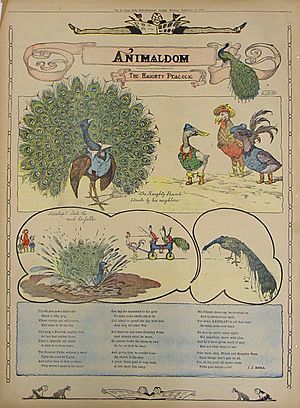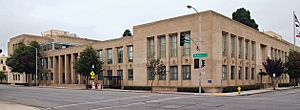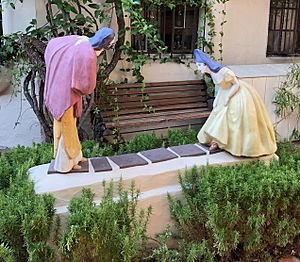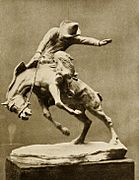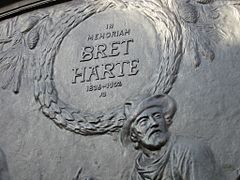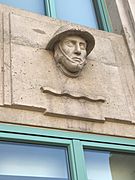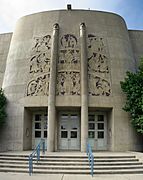Jo Mora facts for kids
Quick facts for kids
Jo Mora
|
|
|---|---|
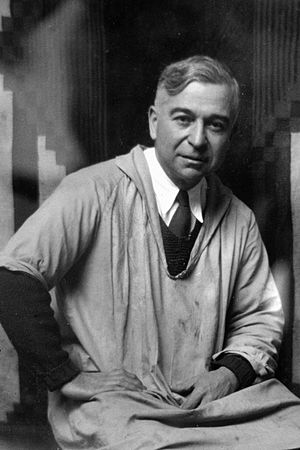
Jo Mora
|
|
| Born |
Joseph Jacinto Mora
October 22, 1876 |
| Died | October 10, 1947 (aged 70) |
| Nationality | Uruguayan-born American |
| Known for | Painting, drawing, sculpture, muralist |
| Style | Realism |
| Spouse(s) | Grace Needham |
Joseph Jacinto Mora (October 22, 1876 – October 10, 1947) was a Uruguayan-born American cowboy, photographer, artist, cartoonist, illustrator, painter, muralist, sculptor, and historian who lived with the Hopi and wrote about his experiences in California. He has been called the "Renaissance Man of the West".
Contents
Early life
Mora was born on October 22, 1876 in Montevideo, Uruguay. His father was the Catalan sculptor, Domingo Mora, and his mother was Laura Gaillard Mora, an intellectual born in the Bordeaux region of France. His elder brother was F. Luis Mora, who would become an artist and the first Hispanic member of the National Academy of Design. The family entered the United States in 1880 and first settled in New York City, and then Perth Amboy, New Jersey.
Jo Mora studied art at the Art Students League of New York and the Cowles Art School in Boston. He also studied with William Merritt Chase. He worked as a cartoonist for the Boston Evening Traveller, and later, the Boston Herald.
In the spring of 1903, Mora arrived in Solvang, California. He stayed at the Donohue Ranch. He made plans to travel to the Southwest to paint and photograph the Hopi. He spent time at the Mission Santa Inés; those photographs are now maintained by the Smithsonian Institution. Mora visited many Spanish missions in California that summer by horseback. He followed the "Mission Trail", also called the "Kings Highway".
In 1904, Mora visited Yosemite. Later, in 1904, to 1906, Mora lived with the Hopi and Navajo near Oraibi, Arizona. He took photographs, painted and otherwise recorded the daily life of these Native Americans, including the Hopi Snake Dance. He learned the Native languages and made detailed drawings of what he observed.
Career
In 1907, Mora returned to California and married Grace Needham. Their son, Joseph Needham Mora, was born on March 8, 1908. The Moras moved to San Jose, California, where Mora continued his work.
On 22 February 1911, the Native Sons of the Golden West Building, in San Francisco, with six terra cotta panels, by Domingo Mora and his son, Jo Mora, was dedicated.
In 1915, he served on the International Jury of Awards at the Panama–Pacific International Exposition and displayed six sculptures.
In 1915-16 two of his sculptural commissions were revealed: the bronze memorial tablet with the profile of the late Archbishop Patrick W. Riordan for the Knights of Columbus and the Cervantes Monument in San Francisco's Golden Gate Park. By 1919, he was sculpting for the Bohemian Club, including the Bret Harte Memorial plaque, completed in August 1919 and mounted on the outside of the private men's club building in San Francisco.
Carmel-by-the-Sea
In 1921, the Mora family relocated to Carmel-by-the-Sea, California, the largest art colony on the West Coast, making it their primary residence. He constructed a Craftsman-style home, which is located on the west side of San Carlos Street, the third house south of 1st Avenue.
Mora received a commission for the bronze and travertine Cenotaph, for Father Junípero Serra in the Memorial Chapel at the west end of Mission Carmel.
Mora served on the board of directors of the Carmel Art Association, where his sculptures were exhibited between 1927 and 1934. He co-established Carmel's first private art gallery which was operated by resident artists.
Jo Mora is a serious sculptor, a responsible amateur actor; when mixed up with pen and ink, a humorist! Comic strips was once his trade. He was famous at it. That was years ago but his art of cartooning bloomed again when in recent years he produced the well known Mora Map of the Monterey Peninsula. Most successful with bronze statue creations which decorate many gardens in East and West. If he has a specialty in figures it is cowboys. He knows his West. Jo Mora will ever be famed for his portrayal of Pancho Lopez, The Bad Man, at Carmel Playhouse. He does everything well and is handsome while doing it. He is happily married-alas!
During the Great Depression, Mora created the "Carmel Dollar" as part of Carmel's program, offering unemployed residents scrip for public service, exchangeable for groceries and essentials; a three-cent stamp on the certificate's back acknowledged their efforts. When full, merchants accepted the certified scrip for goods or a dollar.
Architect Robert Stanton collaborated closely with Mora on multiple projects. In 1937, Stanton was the architect for the Monterey County Courthouse, which incorporated Mora's bas-relief panels, column caps, and figurative heads on both the building's exterior and its interior courtyard.
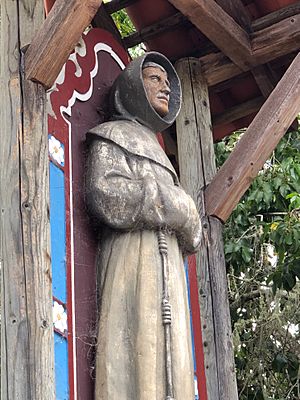
On July 22, 1922, for the opening day of the Carmel Woods subdivision, Mora had carved and painted a wooded statue of Padre Junípero Serra, which was installed within a small wooden shrine, surrounded by plants and a pair of wooden benches at the entrance to the development, at the intersection of Camino del Monte and Alta Avenue.
In 1925, he designed the commemorative half dollar for the California Diamond Jubilee. During this period he also illustrated a number of books, made large murals, and published charts, maps (cartes) and diagrams of the West and Western themes. Beginning in 1937, Mora wrote and illustrated children's books about the West. In 1939, a Works Progress Administration project was completed, with Mora bas-relief sculpture adorning the King City High School Auditorium building.
Pebble Beach
In 1931 Jo, his wife, and daughter Patricia (born June 27th, 1913) moved to nearby Pebble Beach into a newly built home. Five years later in the adjoining large studios he completed his massive diorama, Discovery of the San Francisco Bay by Portola, for the California Pavilion at the 1939-40 Golden Gate International Exposition on Treasure Island. At a length of almost 100 feet, with 64 sculptures of Spaniards and Indians and over 200 animals, it was said "to surpass anything of its kind at the Fair." He fashioned smaller dioramas for the Will Rogers Memorial Museum in Claremore, Oklahoma and the Sutter's Fort Museum in Sacramento, California.
"El Paseo" sculpture
In 1928, Mora made the "El Paseo" sculpture in the courtyard of the El Paseo Building on Dolores Street and 7th Avenue in Carmel. The building was designated in the city's Downtown Historic Conservation District Historic Property Survey on January 24, 2002.
"El Paseo" is a terracotta sculpture of a Californio man and a Señorita woman.
In the early 1930s, Mora was commissioned by Earl F. Graft to decorate the Carmel Dairy Building in Carmel. Mora made three large interior dairy murals above a soda fountain (no longer present) and a sculptured a metal lamp in the shape of a cowbell that still hangs above the buildings front door. He showed animal figures dressed as humans, many recognizable as local Carmel residents. He also designed the menus, Christmas cards, and milk bottles, with these animal characterizations, and a cow that served as the logo. The Santa Rosa Republican described Mora's work with an article having the title: "Carmel's Prosaic Dairy is Art."
Between 1908 and the late 1940s his sculptures, illustrations, watercolors and etchings were frequently exhibited across the United States.
Death
Mora died October 10, 1947, in Monterey, California. His last book, Californios, which was devoted to the life of the rancheros of Alta California, was published posthumously.
In music
- Mora's image, "Evolution of the Cowboy", a 1933 poster, reprinted in 1939, promoting the California Rodeo Salinas, next re-purposed, beginning in 1950, as Levi Strauss & Co. advertising, and later, part of the poster, the image of the Sweetheart of the Rodeo, was used on The Byrds' 1968 album Sweetheart of the Rodeo.
- Western performer Mike Beck's album Where the Green Grass Grows includes a song about Mora entitled "In Old California". It was written by Beck and Ian Tyson.
Coinage
Mora designed the 1925 California Diamond Jubilee half dollar.
Works on the National Register of Historic Places
- Monterey County Court House, Salinas, CA. 1937 courthouse significant as an example of WPA Moderne architecture and the collaboration of architect Robert Stanton and artist Jo Mora.
- Mission San Carlos Borromeo Del Rio Carmelo, 3080 Rio Road, Carmel, Monterey, CA. Father Junipero Serra’s cenotaph, altar cross and Maria Antonio Field sculpture. Bronze, travertine marble, and wood. 1924.
Museum Catalogs
- The Year of the Hopi: Paintings and Photographs by Joseph Mora, 1904-'06, Smithsonian Institution, Washington, D. C., 1979
- Jo Mora: Artist and Writer, Monterey Museum of Art, 1998
- Back to the Drawing Board with Artist Jo Mora, Monterey History and Art Association, Monterey, CA, 2003
Gallery
Additional sources
- The Life and Times of Jo Mora: Iconic Artist of the American West, by Peter Hiller, published by Gibbs Smith (ISBN-10 1423657357)
- Jo Mora Collection website



